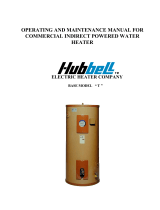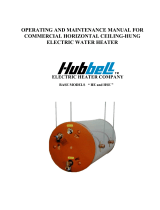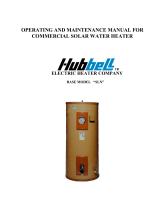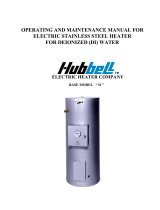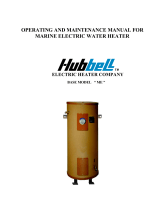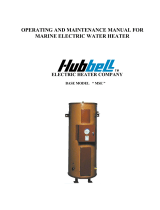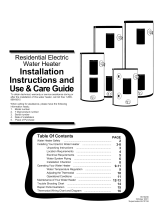Page is loading ...

OPERATING AND MAINTENANCE MANUAL FOR
COMMERCIAL ELECTRIC WATER HEATER
ELECTRIC HEATER COMPANY
BASE MODEL “ CE110 ”

2
HUBBELL
ELECTRIC HEATER COMPANY
P.O.BOX 288
STRATFORD, CT 06615
PHONE: (203) 378-2659
FAX: (203) 378-3593
INTERNET: http://www.hubbellheaters.com/
-- IMPORTANT --
Always reference the full model number and serial number when calling the factory.
The following information should be noted at time of installation and retained for future reference.
Serial No.:
Date Installed:
Dealer's Name:
Address:
City and State:

3
WARNING / CAUTION
1. Please read all instructions prior to installing water heater.
2. Tank is to be completely filled with water and all air is to be vented before energizing.
3. Due to the rigors of transportation, all connections should be checked for tightness before heater
is placed in operation.
4. Safety relief valve must be installed in tapping provided.
5. The refractory material used in heating elements may absorb some moisture during transit,
periods of storage, or when subjected to a humid environment. This moisture absorption results
in a cold insulation resistance of less than twenty (20) megohms. If this heater has been
subjected to the above condition, each heating element must be checked for insulation
resistance before energizing. A low megohm condition can be corrected by removing the
terminal hardware and baking the element in an oven at 350°F -700°F for several hours or until
the proper megohm reading is obtained.
6. KEEP AWAY FROM LIVE ELECTRICAL CIRCUITS.
Do not perform any maintenance, make any adjustments, or replace any components inside the
control panel with the high voltage power supply turned on. Under certain circumstances,
dangerous potentials may exist even when the power supply is off. To avoid casualties, always
turn the power supply safety switch to off, turn the charge or ground the circuit before
performing any maintenance or adjustment procedure.
7. This appliance is designed to store water heated only by the electrical elements provided, at
temperature of not more then 125°F and pressures of not more than 150 psi. Heat input from
any external or additional source will void the warranty.
8. The design anticipates the proper installation and care in use of the product. There is a risk of
property damage and personal injury inherent in these of any hot water system. The Company
cannot supervise the installation and therefore make it a specific condition of the warranty
that the customer will supervise the installation and use of this product to be sure they are
performed in accordance with safe guidelines and proper local or national codes. Generalized
instructions and procedures cannot anticipate all situations. For this reason, only qualified
installers should perform the installations. A qualified installer is a person who has licensed
training and a working knowledge of the applicable codes regulation, tools, equipment, and
methods necessary for safe installation of an electric resistance water heater. If questions
regarding installation arise, check your local plumbing and electrical inspectors for proper
procedures and codes. If you cannot obtain the required information, contact the company.

4
TABLE OF CONTENTS
SECTION TITLE PAGE #
I GENERAL INFORMATION 6
II INSTALLATION GUIDELINES 8
III SCHEDULED MAINTENANCE AND OPERATION 14
IV TROUBLESHOOTING 16
V SERVICING AND REPLACEMENT OF PARTS 17
VI WARRANTY 21

5
PARTS LOCATION DIAGRAM
High Limit
Access Cove
r
Electrical Junction
Box Cove
r
Hot Water
Outlet -
(Cold water
inlet not
shown on
bottom).
High Limit Safety
Switch - Manual reset
switch designed to shut
off all electrical circuits
if water reaches 190°F
Thermostat - For constant
temperature control. Factory
set at 125°F.
Thermostat and Heating
Element Access Cove
r
Long-Life Heating Element -
Waste is reduced with immersed
heating element because all available
heat passes directly into the water.
Low watt density element assures
longer life - and
reduces mineral
build up.
Jacket and Insulation -
Durable & easy-to-clean,
jacket is heavy -gauge
steel, finished with high
gloss enamel. Insulation
consists of high-density
fiberglass blankets.
Temperature &
Pressure Safety
Relief Valve

6
SECTION I - GENERAL INFORMATION
GENERAL DESCRIPTION
This book describes a packaged electric water heater that is a stationary, self-contained unit. The
complete assembly consists of the storage tank, immersion electric heating element(s), thermostat,
safety relief valve, safety high temperature cut out, and any other required electrical operating control.
Optional equipment may be supplied with your unit. Please consult the product drawing for details
specific to your assembly. The unit is factory assembled, insulated, jacketed, painted, wired, tested, and
ready for electrical and plumbing service connections.
CONSTRUCTION
TANK
The one-gallon storage tank is constructed of stainless steel and is designed for a maximum allowable
working pressure of 150 psi (300 psi TP).
TANK CONNECTIONS
The heater is supplied with separate ¼” MNPT cold water and hot water connections. A ¾-inch FNPT
connection is located on the side of the heater for mounting a combination safety temperature and
pressure relief valve. An overflow line should be utilized from the relief valve outlet to a floor drain.
See drawing for locations and sizes.
HEATING ELEMENT
The water heater is supplied with either a 1000 watt or a 450-watt electric immersion heating element
assembly, rated for 120 volts, and composed of a copper sheathed element that is brazed into a 1” NPT
brass plug.
TEMPERATURE HIGH LIMIT SWITCH
As a safety device, a surface mounted high temperature cut-off switch with manual reset, factory set at
190° F, is provided. In the event of an over-temperature condition, the thermostat will disengage the
power from the system. If this switch operates, do not attempt to reset. A dangerous situation is
indicated and a qualified service person should be called to find the source before the unit is operated
again.
Manual Reset

7
CONTROL THERMOSTAT
The temperature of the water in the heater is regulated by the adjustable, automatic, immersion
thermostat located behind the jacket front cover. This automatic control is set at the factory to
maintain a water temperature of 125°F to reduce the risk of scald injury. The thermostat dial is
graduated with markings form 1 to 10 with 10 being the hottest.
Capillary Tube and Bulb
OUTER SHELL AND INSULATION
The tank is encapsulated in 1-inch thick fiberglass insulation. The tank and insulation is protected by a
painted steel protective jacket.
TEMPERING VALVE (Optional)
An optional tempering valve may be supplied to increase the amount of available hot water. The ½”
NPT valve is adjustable from 100° - 130° F and is typically used when supplying hot water to multiple
lavatories from a single CE110.
WALL BRACKET (Optional)
An optional wall bracket is available
for easy mounting of the heater.

8
SECTION II – INSTALLATION GUIDELINES
WARNING / CAUTION
DO NOT TURN ON THE ELECTRIC POWER SUPPLY to this equipment until heater is
completely filled with water and all air has been released. If the heater is NOT filled with water when
the power is turned on, the heating elements will burn out.
For protection against excessive pressures and temperatures, local codes require the installation of a
temperature-and-pressure (T&P) relief valve certified by a nationally recognized laboratory that
maintains periodic inspection of production of listed equipment of materials, as meeting the
requirements for Relief Valves and Automatic Gas Shutoff for Hot Water Supply Systems. ANSI
Z21.22-1971. A relief valve is designed to discharge excessively hot water. THE CUSTOMER IS
RESPONSIBLE TO PROTECT PROPERTY AND PERSONNEL FROM HARM WHEN THE
VALVE FUNCTIONS.
All water heaters have a risk of leakage at some unpredictable time. IT IS THE CUSTOMER'S
RESPONSIBILITY TO PROVIDE A CATCH PAN OR OTHER ADEQUATE MEANS, SO THAT
THE RESULTANT FLOW OF WATER WILL NOT DAMAGE FURNISHINGS OR PROPERTY.
The warranty provided assures replacement within its terms, but specifically does not warrant against
consequential damage caused by failure to follow these instructions.
UNPACKING AND INSPECTING THE HEATER
1. Remove the model CE110 from the shipping carton and visually inspect for any sign of
damage. A damaged unit should not be installed, but returned to the factory for replacement.
WATER HEATER PLACEMENT
1. Locate the heater in a clean, dry location nearest to the point of most frequent hot water use.
2. Secure the water heater. Optional wall mounting brackets may be utilized, if supplied.
3. The water heater should be protected from freezing and waterlines insulated to reduce energy
and water waste.
4. Leave sufficient room to service the heater.
5. Do not install in an area where flammable liquids or combustible vapors are present.

9
PIPING INSTALLATION
NOTE: The most effective means for preventing deterioration from accelerated corrosion due to
galvanic and stray current is the installation of dielectric fittings/unions. The installation of these
fittings is the responsibility of the installing contractor.
1. Connect the cold water inlet and hot water outlet to the appropriate connections as shown;
refer to installation diagram.
2. Provide a shut off valve in the cold water line. Mark for future emergency use
3. If pressure reducers or any other restrictions are put in the cold water line, special precautions
should be taken. Consult you local plumbing inspector
4. Install the combination temperature and pressure safety relief valve in the tapping provided.
Note that this is required by law for safety considerations.
Outlet to floor drain Install into provided tapping
Manual Release
Lever
Temperature and Pressure Relief Valve
5. Install a relief valve overflow pipe to a nearby floor drain. CAUTION: No valve of any type
should be installed between the relief valve and tank or in the drain line.
FILLING THE HEATER
1. Completely close the drain valve.
2. Open the highest hot water faucet to allow all air to escape from piping.
3. Open the valve to the cold water inlet and allow the heater and piping system to completely
fill, as indicated by a steady flow of water from the open faucet.
Temperature Probe

10
ELECTRICAL INSTALLATION
1. Enter the electrical service entrance with properly sized feeder leads, conforming to the
voltage stamped on the rating plate. Note: A separate fused branch circuit, conforming to
local or National Electric Codes, must be provided by a qualified electrician.
2. Connect these power leads to wires enclosed in junction box with wire nuts. Refer to wiring
diagram.
CAUTION: There is a risk of electric shock in an ungrounded service. It is critical that this
unit be wired with a power supply that has a service ground wire available. Be sure to
connect the ground wire to the green ground wire provided in the junction box.
3. Mark the electrical shut off clearly for future emergency use.
4. Field connections with aluminum conductors must use connectors approved for copper to
aluminum connection.
5. All other electrical connections are made at the factory; therefore, no other electrical
connections are necessary.
FINAL CHECKS
1. Check all connections for tightness.
2. Complete following checklist to ensure that all the above steps are completed:
a. Unit unpacked and checked for damage.
b. Heater properly located.
c. Heater properly secured to wall.
d. Cold water line connected to cold water inlet on tank.
e.
Shut-off valve installed on cold water line.
f. Hot water line connected to hot water outlet on tank.
g.
Temperature and pressure relief valve installed.
h. Relief valve overflow line installed.
i.
Water heater filled with water.
j. Power leads connected inside electrical enclosure from separate fused circuit.
k.
Ground wire connected.
3. After the water is heated for the first time, monitor the water temperature as described in
Section III, Quarterly Inspection.

11
Ground L1 L2
High Limit Cutout
Thermostat
Capillary Tube
Heating Element
WIRING DIAGRAM
1
3 4
2

12
INSTALLATION WITHOUT TEMPERING VALVE
Piping to Hot
Wate
r
Support Bracket –
(bottom bracket
not shown)
Piping from
Cold Wate
r
Floor Drain
Air Gap
Drain Valve
Relief Valve
Discharge Pipe
Temperature & Pressure
Relief Valve

13
INSTALLATION WITH TEMPERING VALVE
Tempering
Valve
Piping to
Hot Wate
r
Support Bracket –
(bottom bracket not
shown)
Air Gap
Floor Drain
Relief Valve
Discharge Pipe
Temperature & Pressure
Relief Valve
Piping from
Cold Wate
r
Drain Valve

14
SECTION III - SCHEDULED MAINTENANCE AND OPERATION
WARNING / CAUTION
Before performing any maintenance procedure, make certain power supply is OFF and cannot
accidentally be turned on.
Exposure to 125°F or hotter water can cause scalding injuries. Appropriate caution must be taken
when using hot water. Special supervision must be given to those who cannot react quickly such as
children, invalids, or elderly persons.
MAINTENANCE AND OPERATION
The water heater is automatic in its operation. It will maintain a full tank of water at the temperature
setting of the thermostat. The water heater should not be turned on without first making sure that the
tank is full of water and that all air has been released.
FREEZING
The tank should be fully drained in the event the electricity has been turned off and if there is danger
of freezing.
QUARTERLY INSPECTION
1. Water temperature regulation.
a. Let water heater completely heat to a designated thermostat setting.
b. After thermostat satisfies (i.e., when the thermostat actually clicks off), draw water from heater.
c. Measure the maximum temperature with an accurate thermometer.
d. If the temperature is above the safe limits for your circumstances call a service man to adjust
or replace the control.
2. Lift test lever on relief valve and let water run through valve for a period of approximately 10
seconds. This will help flush away any sediment that might build up in water passageways.
3. Inspect element flange for leakage as follows:
a. Shut off Power Supply.
b. Remove element housing cover.
c. Visually inspect heating element for evidence of leaks.
d. Rub finger around heating element and check for any evidence of moisture. If moisture is
present or a water drip is observed, follow procedure outlined in Section V.
4. Check for loose electrical connections. Tighten as necessary.

15
ANNUAL INSPECTION
1. Flush tank as follows
a. Shut off power supply.
b. Attach a hose to the drain valve installed in the cold water piping.
c. Close valve on the cold water line to the heater.
d. Open the drain valve and direct the water to a drain.
e. Open hot water faucet to admit air into the tank.
f. Close drain valve and hot water faucet.
g. Open valve on the cold water line to the heater.
h. Turn power supply ON.
LONG TERM SHUT DOWN
1. If the water heater is to remain idle for an extended period of time, the power and water to the
heater should be turned off to conserve energy.
2. The water heater and piping should be drained, if they might be subjected to freezing
temperatures.
3. After a long shutdown period, the heater's operations and controls should be checked by
qualified service personnel.
4. Make certain the water heater is filled before placing it in operation.
EMERGENCY
1. Should the heater be subject to flood, fire, or other damaging conditions, turn off the power
and water to the heater.
2. DO NOT place water heater in operation again until it has been thoroughly checked by
qualified service personnel.

16
SECTION IV – TROUBLESHOOTING
Symptom Probable Cause Corrective Action / Remedy
Circuit breaker tripped at source. Reset circuit breaker.
High limit switch tripped. Reset high limit switch.
Loose wires. Tighten wires. Torque screws per torque
chart included in Section VI.
Heating element inoperable. Check heating element operation by
clamping an Amprobe around each wire to
the element. The ampere reading should
agree with the nameplate ‘AMP’ figure.
Low line voltage. Have source electrical system checked by
an electrician.
No hot water
Faulty thermostat. Move thermostat dial through full range. A
definite ‘click’ should be heard. If not,
replace thermostat.
Water temperature
below settings at all
times
Faulty thermostat. Check thermostat adjustment. Monitor
thermostat as described in Section III,
Quarterly Inspection. Replace if necessary.
Relief valve
discharges
continuously
Excessive temperature or
pressure in tank
Temperature and pressure relief valves are
made to operate if the water temperature
exceeds 210°F or water pressure exceeds
the pressure rating of the safety relief valve.
If trouble is excessive temperature, then
thermostat is not shutting off at the right
setting and thermostat must be replaced.

17
SECTION V - SERVICING & REPLACEMENT OF PARTS
WARNING / CAUTION
Before servicing or replacing any part make sure to turn the power supply switch to the OFF position.
SURFACE TEMPERATURE HIGH LIMIT CUT-OFF
1. Disconnect power from unit.
2. Remove access cover.
3. Disconnect the four (4) 14 gauge wires.
Control Wires
4. Remove the two (2) mounting screws.
5. Replace control and install new high limit switch by performing above steps in reverse order;
refer to wiring diagram in Section II. Torque screws per chart in back
Mounting Screws

18
HEATING ELEMENT
1. Disconnect power from unit.
2. Shut off incoming water supply.
3. Attach hose to drain connection.
4. Lift manual release lever on relief valve to let air into system or break union on outgoing
water line.
5. Drain water from tank.
6. Remove access cover.
7. Disconnect the wires from the heating element terminals.
Thermowell
Wires
8. Unscrew heating element.
9. Withdraw element assembly.
Tank Coupling
Element Assembly
10. Install Teflon tape and insert new heating element. Thermowell must be above the heating
element, in the 12 o’clock position.
11. Rewire element; refer to wiring diagram in Section II. Torque screws per chart in back.
12. Reinstall access cover.
13. Fill tank and check around element for any leaks.

19
THERMOSTAT
1. Disconnect power from unit.
2. Remove access cover and locate thermostat.
3. Disconnect the two (2) control wires.
Wires
Capillary Tube
4. Remove capillary tube and bulb from thermowell in element. See previous page.
5. Remove mounting screw and knob.
6. Remove thermostat by sliding out from behind mounting bracket.
Mounting Bracket
Mounting Screw
7. Replace thermostat using the reverse procedure; refer to wiring diagram in Section II.

20
RELIEF VALVE
1. Disconnect power from unit.
2. Shut off incoming water supply.
3. Lift test lever on relief valve to relieve pressure in tank.
4. Disconnect overflow piping.
5. Unscrew relief valve, remove assembly and replace with new one.
6. Connect overflow piping.
7. Turn on incoming water supply and check for leaks.
8. Turn safety switch to ON position.
Test Lever
Overflow Piping Outlet
Tank Connection
Temperature Probe
/
